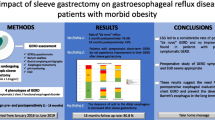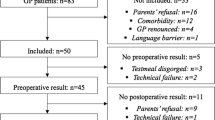Abstract
Background
The effects of laparoscopic adjustable gastric band (LAGB) placement on upper gastrointestinal tract function in obese adolescents are unknown. Therefore, our aim was to determine the short-term effects of LAGB on esophageal motility, gastroesophageal reflux, gastric emptying, appetite-regulatory hormones, and perceptions of post-prandial hunger and fullness.
Methods
This study was part of a prospective cohort study (March 2009–December 2015) in one tertiary referral hospital. The study included obese adolescents (14–18 years) with a body mass index (BMI) > 40 (or ≥ 35 with comorbidities). Gastric emptying was assessed by 13C-octanoic acid breath test, pharyngeal, and esophageal motor function by high-resolution manometry with impedance (HRIM), and appetite and other perceptions using 100-mm visual analogue scales. Dysphagia symptoms were scored using a Dakkak questionnaire. Data were compared pre- and post-LAGB placement and at a 6-month follow-up.
Results
Based upon analysis of 15 adolescents, at the 6-month follow-up, LAGB placement: (i) led to a significant reduction in weight and BMI; (ii) increased fullness and decreased hunger post-meal; (iii) increased symptoms of dysphagia after solid food; and, despite these effects, (iv) caused little or no changes to appetite hormones, while (v) effects on gastric emptying, esophageal motility, esophageal bolus transport, and esophageal emptying were not significant.
Conclusion
In adolescents, LAGB improved BMI and altered the sensitivity to nutrients without significant effects on upper gastrointestinal tract physiology at the 6-month follow-up.







Similar content being viewed by others
References
Booth ML, Denney-Wilson E, Okely AD, et al. Methods of the NSW schools physical activity and nutrition survey (SPANS). J Sci Med Sport. 2005;8(3):284–93.
Smith FJ, Holman CD, Moorin RE, et al. Incidence of bariatric surgery and postoperative outcomes: a population-based analysis in Western Australia. Med J Aust. 2008;189(4):198–202.
Dietz WH. Health consequences of obesity in youth: childhood predictors of adult disease. Pediatrics. 1998;101(3 Pt 2):518–25.
Dietz WH. Overweight in childhood and adolescence. N Engl J Med. 2004;350(9):855–7.
Schwimmer JB, Deutsch R, Rauch JB, et al. Obesity, insulin resistance, and other clinicopathological correlates of pediatric nonalcoholic fatty liver disease. J Pediatr. 2003;143(4):500–5.
Yanovski JA, Yanovski SZ. Treatment of pediatric and adolescent obesity. JAMA. 2003;289(14):1851–3.
Yanovski SZ. Pharmacotherapy for obesity—promise and uncertainty. N Engl J Med. 2005;353(20):2187–9.
Holterman AX, Browne A, Dillard 3rd BE, et al. Short-term outcome in the first 10 morbidly obese adolescent patients in the FDA-approved trial for laparoscopic adjustable gastric banding. J Pediatr Gastroenterol Nutr. 2007;45(4):465–73.
Kentish SJ, Page AJ. The role of gastrointestinal vagal afferent fibres in obesity. J Physiol. 2015;593(4):775–86.
Burton PR, Brown WA. The mechanism of weight loss with laparoscopic adjustable gastric banding: induction of satiety not restriction. Int J Obes (2005). 2011;35(Suppl 3):S26–30.
Borovicka J, Krieger-Grubel C, van der Weg B, et al. Effect of morbid obesity, gastric banding and gastric bypass on esophageal symptoms, mucosa and function. Surg Endosc. 2017;31(2):552–60.
Cote-Daigneault J, Leclerc P, Joubert J, et al. High prevalence of esophageal dysmotility in asymptomatic obese patients. Can J Gastroenterol Hepatol. 2014;28(6):311–4.
Mora F, Cassinello N, Mora M, et al. Esophageal abnormalities in morbidly obese adult patients. Surg Obes Relat Dis: Off J Am Soc Bariatric Surg. 2016;12(3):622–8.
Wiesner W, Hauser M, Schob O, et al. Pseudo-achalasia following laparoscopically placed adjustable gastric banding. Obes Surg. 2001;11(4):513–8.
Hyman B, Kooi K, Ficklen D. Bariatric surgery in adolescents. J Sch Health. 2008;78(8):452–4.
Inge TH, Krebs NF, Garcia VF, et al. Bariatric surgery for severely overweight adolescents: concerns and recommendations. Pediatrics. 2004;114(1):217–23.
Inge TH, Zeller M, Harmon C, et al. Teen-longitudinal assessment of bariatric surgery: methodological features of the first prospective multicenter study of adolescent bariatric surgery. J Pediatr Surg. 2007;42(11):1969–71.
Nadler EP, Youn HA, Ginsburg HB, et al. Short-term results in 53 US obese pediatric patients treated with laparoscopic adjustable gastric banding. J Pediatr Surg. 2007;42(1):137–41. discussion 41-2
O'Brien PE, Sawyer SM, Laurie C, et al. Laparoscopic adjustable gastric banding in severely obese adolescents: a randomized trial. JAMA. 2010;303(6):519–26.
Peña AS, Delko T, Couper R, Sutton K, Kritas S, Omari T, Chisholm J, Kow L, Khurana S. Laparoscopic Adjustable Gastric Banding in Australian Adolescents: Should It Be Done?. Obes Surg. 2017;27(7):1667-1673. https://doi.org/10.1007/s11695-017-2544-6
Symonds EL, Omari TI, Webster JM, et al. Relation between pancreatic lipase activity and gastric emptying rate in children with cystic fibrosis. J Pediatr. 2003;143(6):772–5.
Parker BA, Sturm K, MacIntosh CG, et al. Relation between food intake and visual analogue scale ratings of appetite and other sensations in healthy older and young subjects. Eur J Clin Nutr. 2004;58(2):212–8.
Sepple CP, Read NW. Gastrointestinal correlates of the development of hunger in man. Appetite. 1989;13(3):183–91.
Kahrilas PJ, Bredenoord AJ, Fox M, et al. The Chicago classification of esophageal motility disorders, v3.0. Neurogastroenterol Motil: Off J Eur Gastrointest Motil Soc. 2015;27(2):160–74.
Omari TI, Dejaeger E, Tack J, et al. An impedance-manometry based method for non-radiological detection of pharyngeal postswallow residue. Neurogastroenterol Motil. 2012;24(7):e277–84.
Omari TI, Dejaeger E, van Beckevoort D, et al. A method to objectively assess swallow function in adults with suspected aspiration. Gastroenterology. 2011;140(5):1454–63.
Omari TI, Rommel N, Szczesniak MM, et al. Assessment of intraluminal impedance for the detection of pharyngeal bolus flow during swallowing in healthy adults. Am J Physiol Gastrointest Liver Physiol. 2006;290(1):G183–8.
Cock C, Omari T. Diagnosis of swallowing disorders: how we interpret pharyngeal manometry. Curr Gastroenterol Rep. 2017;19(3):11.
Cock C, Besanko L, Kritas S, et al. Maximum upper esophageal sphincter (UES) admittance: a non-specific marker of UES dysfunction. Neurogastroenterol Motil. 2016;28(2):225–33.
Cock C, Besanko L, Kritas S, et al. Impaired bolus clearance in asymptomatic older adults during high-resolution impedance manometry. Neurogastroenterol Motil: Off J Eur Gastrointest Motil Soc. 2016;28(12):1890–901.
Omari TI, Szczesniak MM, Maclean J, et al. Correlation of esophageal pressure-flow analysis findings with bolus transit patterns on videofluoroscopy. Dis esophagus: Off J Int Soc Dis Esophagus. 2016;29(2):166–73.
Omari TI, Wauters L, Rommel N, et al. Oesophageal pressure-flow metrics in relation to bolus volume, bolus consistency, and bolus perception. United European Gastroenterol J. 2013;1(4):249–58.
Singendonk MM, Kritas S, Cock C, et al. Pressure-flow characteristics of normal and disordered esophageal motor patterns. J Pediatr. 2015;166(3):690–6.e1.
Brink GJ, Lei WY, Omari TI, Singendonk MMJ, Hung JS, Liu TT, Yi CH, Chen CL.Physiological augmentation of esophageal distension pressure and peristalsis during conditions of increased esophageal emptying resistance. Neurogastroenterol Motil. 2017. https://doi.org/10.1111/nmo.13225
Lin Z, Carlson DA, Dykstra K, et al. High-resolution impedance manometry measurement of bolus flow time in achalasia and its correlation with dysphagia. Neurogastroenterol Motil: Off J Eur Gastrointest Motil Soc. 2015;27(9):1232–8.
Lin Z, Imam H, Nicodeme F, et al. Flow time through esophagogastric junction derived during high-resolution impedance-manometry studies: a novel parameter for assessing esophageal bolus transit. Am J Physiol Gastrointest Liver Physiol. 2014;307(2):G158–63.
Dakkak M, Bennett Jr A. New dysphagia score with objective validation. J Clin Gastroenterol. 1992;14(2):99–100.
Cigdem Arica P, Kocael A, Tabak O, et al. Plasma ghrelin, leptin, and orexin-A levels and insulin resistance after laparoscopic gastric band applications in morbidly obese patients. Minerva Med. 2013;104(3):309–16.
Gamagaris Z, Patterson C, Schaye V, et al. Lap-band impact on the function of the esophagus. Obes Surg. 2008;18(10):1268–72.
Tolone S, Savarino E, Yates RB. The impact of bariatric surgery on esophageal function. Ann N Y Acad Sci. 2016;1381(1):98–103.
Weiss H, Labeck B, Klocker J, et al. Effects of adjustable gastric banding on altered gut neuropeptide levels in morbidly obese patients. Obes Surg. 2001;11(6):735–9.
Iovino P, Angrisani L, Tremolaterra F, et al. Abnormal esophageal acid exposure is common in morbidly obese patients and improves after a successful Lap-band system implantation. Surg Endosc. 2002;16(11):1631–5.
Weiss HG, Nehoda H, Labeck B, et al. Treatment of morbid obesity with laparoscopic adjustable gastric banding affects esophageal motility. Am J Surg. 2000;180(6):479–82.
Dargent J. Esophageal dilatation after laparoscopic adjustable gastric banding: definition and strategy. Obes Surg. 2005;15(6):843–8.
Milone L, Daud A, Durak E, et al. Esophageal dilation after laparoscopic adjustable gastric banding. Surg Endosc. 2008;22(6):1482–6.
Carlson DA, Omari T, Lin Z, Rommel N, Starkey K, Kahrilas PJ, Tack J, Pandolfino JE. High-resolution impedance manometry parameters enhance the esophageal motility evaluation in non-obstructive dysphagia patients without a major Chicago Classification motility disorder. Neurogastroenterol Motil. 2017;29(3). https://doi.org/10.1111/nmo.12941.
de Jong K, Mathus-Vliegen EM, Veldhuyzen EA, et al. Short-term safety and efficacy of the Trans-oral Endoscopic Restrictive Implant System for the treatment of obesity. Gastrointest Endosc. 2010;72(3):497–504.
Woodman G, Cywes R, Billy H, et al. Effect of adjustable gastric banding on changes in gastroesophageal reflux disease (GERD) and quality of life. Curr Med Res Opin. 2012;28(4):581–9.
DeMaria EJ, Sugerman HJ, Meador JG, et al. High failure rate after laparoscopic adjustable silicone gastric banding for treatment of morbid obesity. Ann Surg. 2001;233(6):809–18.
Gutschow CA, Collet P, Prenzel K, et al. Long-term results and gastroesophageal reflux in a series of laparoscopic adjustable gastric banding. J Gastrointest Surg: Off J Soc Surg Aliment Tract. 2005;9(7):941–8.
Tolonen P, Victorzon M, Niemi R, et al. Does gastric banding for morbid obesity reduce or increase gastroesophageal reflux? Obes Surg. 2006;16(11):1469–74.
Dixon JB, Chapman L, O'Brien P. Marked improvement in asthma after Lap-Band surgery for morbid obesity. Obes Surg. 1999;9(4):385–9.
Chen RY, Burton PR, Ooi GJ, Laurie C, Smith AI, Crosthwaite G, O'Brien PE, Hebbard G, Nottle PD, Brown WA.The Physiology and Pathophysiology of Gastroesophageal Reflux in Patients with Laparoscopic Adjustable Gastric Band. Obes Surg. 2017;27(9):2434-2443. https://doi.org/10.1007/s11695-017-2662-1.
Hornby PJ, Abrahams TP. Central control of lower esophageal sphincter relaxation. Am J Med. 2000;108(Suppl 4a):90s–8s.
Steinert RE, Feinle-Bisset C, Asarian L, et al. GLP-1, and PYY(3-36): secretory controls and physiological roles in eating and Glycemia in health, obesity, and after RYGB. Physiol Rev. 2017;97(1):411–63.
Kampe J, Brown WA, Stefanidis A, et al. A rodent model of adjustable gastric band surgery-implications for the understanding of underlying mechanisms. Obes Surg. 2009;19(5):625–31.
Aneta Stefanidis PD, Forrest N, Brown WA, et al. An investigation of the neural mechanisms underlying the efficacy of the adjustable gastric band. Surg Obes Relat Dis: Off J Am Soc Bariatric Surg. 2016;12(4):828–38.
Kampe J, Stefanidis A, Lockie SH, et al. Neural and humoral changes associated with the adjustable gastric band: insights from a rodent model. Int J Obes (2005). 2012;36(11):1403–11.
Ryder JR, Edwards NM, Gupta R, et al. Changes in functional mobility and musculoskeletal pain after bariatric surgery in teens with severe obesity: teen-longitudinal assessment of bariatric surgery (LABS) study. JAMA Pediatr. 2016;170(9):871–7.
Funding
Author 1 received a travel grant from the KNAW Termeulen Fund. There was no other external funding for this manuscript.
Author information
Authors and Affiliations
Corresponding author
Ethics declarations
Conflicts of Interest
Author 3 holds inventorship of Australian Patent 2011301768 that covers some of the analytical methods described. The other authors have no conflicts of interest relevant to this article to disclose.
Informed Consent
Informed consent was obtained from all individual participants included in this study.
Ethical Approval
All procedures performed in studies involving human participants were in accordance with the ethical standards of the institutional and/or national research committee and with the 1964 Helsinki declaration and its later amendments or comparable ethical standards.
Additional information
M Singendonk and S Kritas joint first authorship
Rights and permissions
About this article
Cite this article
Singendonk, M., Kritas, S., Omari, T. et al. Upper Gastrointestinal Function in Morbidly Obese Adolescents Before and 6 Months After Gastric Banding. OBES SURG 28, 1277–1288 (2018). https://doi.org/10.1007/s11695-017-3000-3
Published:
Issue Date:
DOI: https://doi.org/10.1007/s11695-017-3000-3




